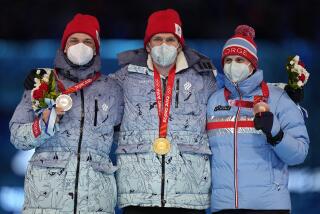SKI JUMPING
- Share via
The breath-taking event in which competitors hurl themselves off the end of a long ramp, into the air and down a mountainside, was first contested in the Winter Olympics in 1924. A second, bigger hill was added in 1964 and since then the event has been divided into large-hill and normal-hill jumping. Individual competition will take place on both hills and team competition on the Large Hill. Only men compete in ski jumping.
People to Watch
Primoz Peterka of Slovenia. In the best traditions of ski jumping, he came out of nowhere last season and won the World Cup title at 17. He has not been as impressive this season, but good young jumpers have a way of taking over in Olympic competition.
The Japanese, with the home-hills advantage, are taking ski jumping very seriously this Olympic year. With Masahiko Harada leading the way, the Japanese have been dominant in World Cup jumping this season. And in Nagano, Harada will have something to prove. Japan was on its way to what would have been the country’s only gold medal of the Games in the team event off the large hill at Lillehammer four years ago, needing only an average second jump from Harada to clinch it. Instead, Harada jumped poorly, sailing only 319 feet 9 inches after a first leap of 400-3 1/2. And Germany, with a sensational final jump of 444-6 by the now-retired Jens Weissflog, won the gold, Japan settling for silver. In last year’s World Championships, Harada won the individual title on the large hill, was second on the normal, and Japan was second, to Finland, in the team competition. Finland, with a new young team, looms as Japan’s major competition at Nagano.
Inside Info
Ski Jumping offers Japan its best opportunities for medals in these Games. How the favored Japanese will react to that pressure is unknown. On the other hand, local vocal support may be just the inspiration they need.
Ski jumping in recent years has moved away from the normal or small hill--there were only two normal-hill meets on this season’s World Cup schedule--but the normal hill remains in the Olympics, giving jumpers three opportunities for medals. Ski jumping was changed dramatically in the late 1980s by the introduction of the V-style. Using the V-technique, the skier pushes his skis into a V--tails together, tips far apart--after take-off and flattens his body, arms held at his sides, to become a human airfoil. The more air under the body, the greater the lift and the longer the jump.
Competition
* After receiving a start signal, jumpers have 15 seconds to leave the tower and descend a steel ramp that curves upward at the end.
* They take off by leaping into the air, trying to cover as much distance as possible and still maintain aesthetic form.
* Jumps are classified by the distance from ramp’s end most skiers could soar and land safely.
* At the Olympics, 90 meters (about 100 yards) for the normal hill and 120 meters (132 yards) for the large hill.
* The two distances are called the critical (or K) point and represent the spot beyond which skiers try to land.
Scoring
Five judges award points, with the combined score determining rank. Each skier receives two jumps.
Style: Maximum 20 points; highest and lowest scores are dropped and remaining three totaled. Take-off timing, stability and overall balance are key factors. Maximum of four points may be deducted if skier does not land in telemark position (one leg in front of the other), 10 points maximum for a fall.
Distance: Sixty points awarded for landing at the K point. On normal-hill jumps, two points added for every meter beyond K point, two subtracted for each meter short; 1.8 points on the large-hill jumps. Distance is measured from K point to midway between where skier’s legs landed.
Equipment
Boots: Soft outer shell, high back and low-cut front help skiers lean forward during flight.
Skis: Extra length (about 8.5 feet) and an underside groove help skiers achieve maximum tracking as they zoom down the ramp. Greater width (up to 4.5 inches) provides better lift.
Bindings: Only the boot toe is secured to the skis. A heel wedge helps lift the boot off the ski, a cord connecting the heel to the ski provides in-flight stability.
Anatomy of a Jump
Ski-jumping is divided into four basic parts, with the skier changing positions in each:
Inrun: Skier leaves start tower, assuming a tuck position to minimize air resistance; speeds approximately 50 mph on normal hill and 55 on large hill.
Take-off: Strength, orientation to ramp end and timing are important elements as skier springs out and upward.
Flight: Leaning forward and adjusting skis to a V shape helps maintain lift. Ski jumpers attain speeds of about 60 mph in the air.
Landing: Skier bends hips, knees and ankles and places one foot ahead of other to help absorb impact, which can be as much as three times body weight. Skier halts momentum by turning once on the ground.
Sources: Organizing Committee for the XVIII Olympic Winter Games, Encyclopaedia Britannica, Times reports; Researched by TOM REINKEN and MIKE KUPPER/Los Angeles Times
More to Read
Go beyond the scoreboard
Get the latest on L.A.'s teams in the daily Sports Report newsletter.
You may occasionally receive promotional content from the Los Angeles Times.






